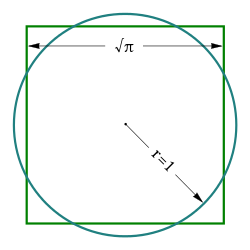We were talking about "squaring the circle".
From
the wikipedia article:
Squaring the circle: The areas of this square and this circle are equal.
In 1882, it was proven that this figure cannot be constructed in a finite number of steps with an idealized compass and straightedge.
(Bold added by me.)
Contrary to the article, Motor Daddy thinks "squaring the circle" can be done in just a few steps, by using the intersection points of two circles which are one radius apart, center-to-center. He also does not realise that any straight line drawn from the center of a circle to a point on the edge of that circle is a radius, which by definition is one radius in length.




